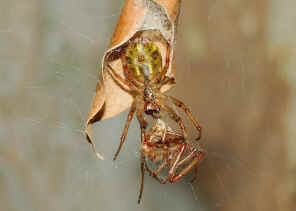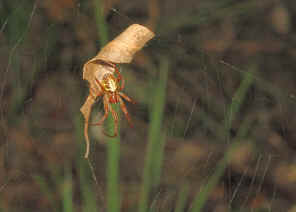Leaf Curling Spider - Phonognatha graeffei
FAMILY ARANEIDAE
This page contains pictures and information about Leaf Curling Spiders that we found in the Brisbane area, Queensland, Australia.

- Body length 12mm
- Leaf Curling Spiders are easily found in open bushland in Brisbane. We saw many of them in late summer. The female spider build the retreat and egg-sac by curling dry leaf. It usually hangs from a twig near the web. Male spider is a little smaller than the female.



- The spider seldom goes outside their leaf retreat unless a prey fall on its web, or it has to repair or re-build its web. The spider usually re-build its web at night.


- When outside its retreat, the spider is in high alert. It will rush back even if there is a minor disturb. The spider has brown legs and brown thorax. Its abdomen is white in colour with dark patterns.
-



- Although most of the Leaf Curling Spiders build their retreat with dry leaf, usually dry gum leaf. Sometime we found them build retreat with newly dropped fresh green leaf.
-



-



- This species was in family Araneidae (formerly Argiopidae), Then it was put in family Nephilidae and then put in Tetragnathidae. Very confusing? Yes, We think so too. Now it was put back in family Araneidae.



- We found this male spider in Karawatha Forest on Dec 2007. From the patterns on its abdomen, we guessed it might be the Bush Orb Weaver male. The spider was resting on a leaf. After we took a few photos, the spider started for "Kiting". A few seconds later, it escaped along the kiting silk.



Male
The Leaf Curling Spider web



- The Leaf Curling Spiders build vertical fan-shaped web, or half of a orb web, usually 0.5 meter in diameter, one meter above the ground.
-



- They always build a retreat on the upper side of their web. Usually they build the retreat by a dry leaf. They stay inside their retreat, put their forelegs on their web and sense if any prey come into their web. If disturbed, they quickly hide inside the retreat.
- The dry leaf retreats and webs shown about could be belong to another species, the Leaf Roller Spider, which also build the similar web and retreat.
- Peter Newnam in Sydney found a Leaf Curling Spider that made its retreat using snail shell instead of dry curled leaf.


- Photos thank to Peter Newnam
- It is easily understood that the spider may miss-judge the snail shell as dry curled leaf. Peter Newnam and his wife also suggested that the spider was in the tee-tree bushes where the dry leaves on ground were only the small tea-tree leaves. The snail shell could be the only suitable materials.
- We wondered how the spider lifted the snail shell up onto its web. The snail shell seems too heavy for the spider.
- We used to think that Leaf Curling Spider uses fallen leaves which dropped and attached onto the spider web for nesting. From the snail shell clue, it is reasonable to believe that the spider chooses suitable materials from ground, usually dry leaf and rarely snail shell, then lift it up onto its web and makes the retreat.
- Reference:
- 1. Leaf-curler - The Find-a-spider Guide for Australian Spiders, University of Southern Queensland, 2007.
- 2. A Guide to Australian Spiders - Densey Clyne, Melbourne, Nelson 1969, p70.
- 3. Australian Spiders in colour - Ramon Mascord, Reed Books Pty Ltd, 1970, p70.
- 4. Species Phonognatha graeffei (Keyserling, 1865) - Australian Faunal Directory, Australian Biological Resources Study.
- 5. Sexual cohabitation as mate-guarding in the leaf-curling spider Phonognatha graeffei Keyserling (Araneoidea, Araneae) - Babette F. Fahey á Mark A. Elgar, Behav Ecol Sociobiol (1997) 40: 127±133, 1996.
- 6. Phonognatha graeffei Leaf Curling Spider - Save Our Waterways Now.
